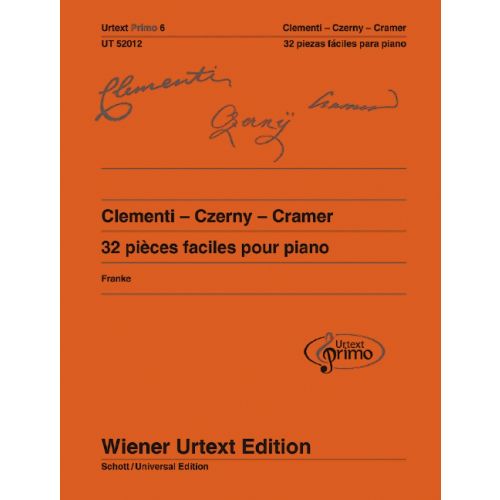Clementi - Czerny - Cramer
Product Details
Description
With works by Clementi, Czerny and Cramer, Urtext Primo 6 contains easy piano music by three composers who all stood out as piano teachers publishing piano methods and study literature. Not only is there a selection of popular sonatinas by Muzio Clementi, there are also selected pieces by Carl Czerny and repertoire by Johann Baptist Cramer (known from the studies of Cramer-Bülow) which will liven up any piano lesson.
Contents
M. Clementi: Sonatine, op. 36/1
M. Clementi: Tarantella
M. Clementi: Sonatine, op. 36/2
M. Clementi: Rondo
C. Czerny: Allegretto vivace, op. 453/31
C. Czerny: Allegretto, op. 453/35
C. Czerny: Andante espressivo, op. 453/45
C. Czerny: Molto Allegro, op. 453/46
C. Czerny: Allegretto, op. 500/I/65
C. Czerny: Allegro, op. 500/I/86
C. Czerny; Allegretto, op. 500/I/90
C. Czerny: Andantino sostenuto, op. 500/I/92
C. Czerny: Marcia funebre, op. 500/I/98
C. Czerny: Andante de, op. 500/II
C. Czerny: Adagio de, op. 500/III
C. Czerny: Adagio non trippo de, op. 500/III
C. Czerny: Andantino de, op. 500/III
C. Czerny: Allegro moderato en si Mineur
C. Czerny: Moderato en ut dièse majeur
C. Czerny: Rondo alla Pollaca
C. Czerny: Etüde, op. 161/25
J.B. Cramer: Le Petit Tambour
J.B. Cramer: Rondo alla Turca
J.B. Cramer: Albumblatt
J.B. Cramer: Präludium und Polacca
J.B. Cramer: The Hartzfeld New Waltz
J.B. Cramer: Andante mit Variationen
J.B. Cramer: Cantabile
J.B. Cramer: Etüde, op. 30/16
J.B. Cramer: Etüde, op. 30/12
J.B. Cramer: Andantino espressivo
More Information
Technical Details
More from this series
Standard works of music literature in the original text
The Wiener Urtext Edition is a scientific critical edition for prac-tice and differs from other editions declared as "original text" in that it contains extensive textual informa-tion in German and English (partly French):
Its preface informs about the work, its genesis and significance for the history of music, about written records and problems of the wording of the text as well as about the respective method applied for editing. Despite their necessary briefness, the critical annotations clearly account for editorial decisions and mention textual divergence going back to the author himself. The music text itself was produced on the basis of an exact checking of all sources by experienced musico-logists. Autographs, first editions, copies and patterns for engravings were used.
In some cases, these materials were analysed completely for the first time. Editions for teaching, studies, concert practice, including comprehensive information about the works by detailed introductions and editorial notes and notes on interpretation. Prepared for practice by interpreters resp. educationalists of international repute.









